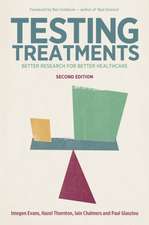Estrogen — Mystery Drug for the Brain?: The Neuroprotective Activities of the Female Sex Hormone
Autor Christian Behlen Limba Engleză Paperback – 12 sep 2012
| Toate formatele și edițiile | Preț | Express |
|---|---|---|
| Paperback (1) | 713.33 lei 6-8 săpt. | |
| SPRINGER VIENNA – 12 sep 2012 | 713.33 lei 6-8 săpt. | |
| Hardback (1) | 722.84 lei 6-8 săpt. | |
| SPRINGER VIENNA – 22 iun 2001 | 722.84 lei 6-8 săpt. |
Preț: 713.33 lei
Preț vechi: 750.88 lei
-5% Nou
Puncte Express: 1070
Preț estimativ în valută:
136.49€ • 142.51$ • 112.97£
136.49€ • 142.51$ • 112.97£
Carte tipărită la comandă
Livrare economică 04-18 aprilie
Preluare comenzi: 021 569.72.76
Specificații
ISBN-13: 9783709172544
ISBN-10: 3709172543
Pagini: 252
Ilustrații: XV, 231 p.
Dimensiuni: 155 x 235 x 13 mm
Greutate: 0.36 kg
Ediția:Softcover reprint of the original 1st ed. 2001
Editura: SPRINGER VIENNA
Colecția Springer
Locul publicării:Vienna, Austria
ISBN-10: 3709172543
Pagini: 252
Ilustrații: XV, 231 p.
Dimensiuni: 155 x 235 x 13 mm
Greutate: 0.36 kg
Ediția:Softcover reprint of the original 1st ed. 2001
Editura: SPRINGER VIENNA
Colecția Springer
Locul publicării:Vienna, Austria
Public țintă
ResearchCuprins
General abbreviations.- 1. Introduction.- Estrogen — more than “just” a female sex hormone.- Estrogen is a hormone: but what are hormones, anyway?.- A little history.- How do hormones act?.- Estrogen — THE sex hormone and more.- 2. Estrogen is a steroid.- Production of sex hormones in the gonadal glands.- Biosynthesis of sex hormones.- 3. Estrogen acts via receptors.- “Estrogen’s classics” — the genomic pathway of estrogen action.- Modulation of the estrogen receptor function.- To be or not to be? Are there membrane ERs?.- 4. “Non-classical” activities of estrogen.- Rapid non-genomic effects compared to slow genomic effects of steroid hormones: what makes the difference?.- Rapid effects of estrogen.- Structure-dependent effects: estradiol as antioxidant.- Reactive oxygen species (ROS): normal byproducts of life under oxygen.- Antioxidant defense lines of the cell.- Estradiol is an antioxidant similar to ?-tocopherol (vitamin E).- Dietary phenols and the blood-brain-barrier.- 5. General physiological activities of estrogen.- Lessons from the ERKO-mice.- 6. Estrogen’s actions in the brain.- Estrogen receptors in the brain.- Neuroactivities of estrogens in brain areas outside the hypothalamus: the effect of sex differences.- Effects of estrogen on the cholinergic system.- Effects of estrogen on the serotonergic and catecholaminergic system.- Activities of estrogen on glial cells.- Are there gender differences in brain function?.- Sexual differentiation and gross gender differences in brain structure and function.- Sex differences in the function of the hippocampus.- “Non-classical” activities of estrogen in the brain.- Estrogen as “neuroactive steroid” and estradiol’s non-genomic effects at neuronal membranes 79 Estrogen’s“cross-talks” with the intracellular signaling in neurons.- Estrogen and MAP kinase signaling.- Estrogen’s “cross-talk” with other signal pathways in neurons.- Estrogen is a phenolic antioxidant.- The pathogenetic role of oxidative stress in the CNS.- The brain is particularly sensitive to oxidative stress.- 7. Protection of the brain by estrogen.- Estrogen as drug for the brain?.- Menopause, and estrogen replacement therapy (ERT).- Estrogen and human diseases: general beneficial effects of estrogen.- Estrogen as a drug for the treatment and prevention of brain diseases?.- Estrogen in neuropsychiatric disorders.- 8. Nerve cell protection by estrogen: molecular mechanisms.- Life is difficult, at the cellular and molecular level, too.- Protective effect of estrogen in cultured neuronal cells.- Mechanisms of nerve cell death.- The two main routes to cell death: apoptosis and necrosis.- Executioners of apoptosis: caspases.- How to detect apoptosis?.- Is there apoptosis in Alzheimer’s Disease?.- Apoptosis in post-mortem AD brain tissue.- Apoptosis and necrosis of nerve cells in culture (in vitro).- AD genetics and apoptosis.- Investigations of estrogen’s neuroprotective activities in vitro.- Intracellular molecular mechanisms of neuroprotection by estrogen.- Direct ER-dependent neuroprotection: induction of neuroprotective genes.- “Cross-Talks” of estradiol with neuroprotective signaling.- MAP-kinase signaling.- Phosphatidylinositol 3 (PI3)-kinase.- NF-?B.- NF-?B is an oxidative stress-responsive transcription factor.- NF-?B has anti-apoptotic and pro-apoptotic activities.- Cyclic AMP/CREB-signaling.- Intracellular Cat2+levels and electrophysiology.- Estradiol is a neuroprotective antioxidant: ER-independent effects.- Oxidative stress as a generaltrigger of nerve cell death.- Oxidative stress in neurodegeneration.- Estradiol is a neuroprotective antioxidant.- 9. Outlook.- Estrogen’s neuroprotective target genes and estrogen’s effects on neuronal stem cells.- Estrogen and stem cells.- 10. References.
Caracteristici
Basic introduction as well as reference book Comprehensive up-to-date information From bench to bed": from molecular structure to clinical application Estrogen's role in Alzheimer's disease, menopause, and age-related disorders
















